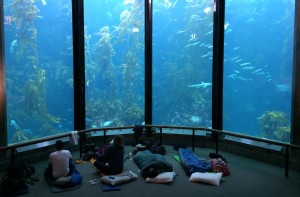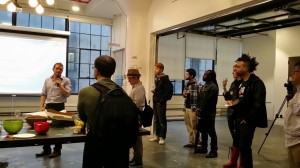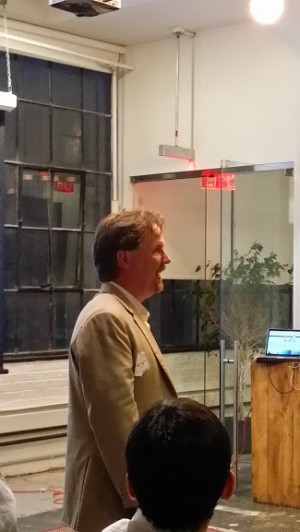Stopping overfishing in PH? There’s an app for that now
• Fishackathon aimed for app that eases fishing licensing and monitoring processes
• Winning Berkeley-based team to go to PH to meet with fisherfolk, researchers, local officials

Winning Berkeley-based fishackathon team spent two-day design time at Monterey Bay Aquarium. PHOTO BY ISHA DANDAVATE
NEW YORK—How do you solve overfishing in the Philippines, one of the top 10 producers of fish worldwide? It looks like there’s an app for that now.
From June 13, 10 pm and 40 hours of fishackathon later (in Boston, Baltimore, Miami, even Silicon Valley), a winner emerged: Hackers from the University of Berkeley-School of Information came up with a tool called Fish DB.
The tool is a three-pronged approach to the problem: for the “ideal world,” a browser-based mobile app for fishermen to submit registration and license applications; for the “real world,” the use of SMS text messages, which does not require internet access and lastly, a web app for government employees to process the submissions.
The mobile app was designed to be as usable as possible for even fishers with marginal literacy: many of the menu options include pictures or diagrams to supplement the textual descriptions. Yes, fishers will need a mobile phone.
To use the app, fishers register their boats, get fishing licenses, and report any illegal fishing activity that they observe. It serves both fishers who need to submit registrations and the government staff who process them.
The winning team from Berkeley received the grand prize: a free trip to the Philippines courtesy of The Office of Global Partnerships & Tone.
The purpose of the trip is to allow them to meet first hand with local fishers, researchers and local officials to get a deeper understanding of how technology can be integrated in coastal communities.
Global initiative
“The State Department organized the fish hackathon. Greenwave (committed to doing it in) in New York,” said Thomas Buck, deputy director of SSG Advisors. He provides assistance to corporate clients and government and non-governmental agencies in building sustainable developmental practices.
Sustaining fishing on a global scale is a major concern of John Kerry, US Secretary of State. In a statement, he said the ocean is being threatened in various ways. ‘It’s threatened by unsustainable fishing, by pollution, by climate change. Indeed, how we respond to these challenges is literally going to help determine the future of our planet.”
But the initiative behind the scenes also comes from a host of organizations, particularly ECOFISH (the Ecosystems Improved for Sustainable Fisheries (ECOFISH) and SSG Advisors. “The State Department asked us to think of the problem that technology may be able to solve,” Buck said.
The Philippine and US connection is based on the alliance between the Philippine government through the Department of Agriculture-Bureau of Fisheries and Aquatic Resources (D-BFAR) and the US government through USAID. ECOFISH has been a five-year initiative that builds on progress made under the DA-BFAR.
Lawrence Ang, ECOFISH public-private partnership specialist, said, “The ECOFISH project facilitated the development of the problem statement that led to the fishackathon.”
In May this year, Ang said ECOFISH convened a round table discussion consisting of government officials within the Dept of Agriculture Bureau of Fisheries and Aquatic Resources’s (BFAR) National Stock Assessment Program Team, SMART Communications and IDEASPACE foundation.
Ang and Buck worked with ECOFISH in crafting the problem statement. “There’s a lot of overfishing. Nobody knows exactly how much fish is being pulled out of the ocean.”
The problem statement focused on expanding and enhancing the data sources for assessing fish stocks in critical fisheries across the Philippines to improve science-based fisheries management.
Catching data
The winning hack or toll is a long way from the inefficient and out-of-date approaches to collecting fish catch information. Current data collection is done with a weighing scale, a meter-long ruler, a field guide for species identification, and paper data sheets which are filled out by hand. This is considered slow and sometimes inaccurate.
Taking measurements also takes time. One or two data collectors are assigned to five landing centers, at which monitor catch data 21 days per month, per site.
Small-scale fishers haul in nets with different types of fish species, all of which must be documented. Illustrative information to be collected includes catch time, vessel type, gear type, catch type, catch volume, catch length, and geographical area of fishing ground.
Is there an accurate way of logging all required information?
According to ECOFISH, data collection surveys reach only 2 percent of identified landing sites. It is difficult to reach all catch landing sites as they include stretches of beach, areas near the market, and other “unofficial” catch landing sites in addition to landing centers and fish landing. On top of this, data collection is done on the shore, not on the ocean. In all landing sites, the goal is to increase comprehensive catch data collection by 20 percent.
“So what if we gave them (fishers) a smartphone or some other device which they can use to collect data?” Buck said, pointing out how an existing app that allows you to take a photo of a bird and find out its species can also apply to fish.
With such a tool, ECOFISH can create the impact it’s looking forward to accomplishing in Lingayen Gulf, Verde Island Passage, Calamianes Island Group, Ticao-San Bernardino-Lagonoy Gulf, Danajon Reef, South Negros Island, Surigao del Sur-Surigao del Norte, and Sulu Archipelago.
The hackers
There were as many as 10 finalists with other hackers and team from various US sites tackling the challenges countries like the Philippines, Ghana and West Africa are facing right now. In New York the hack participants were Kevin Ehsani, Edgar Aroutiounian, Paula Diaz, Yangbo Du, Gary Chan, Lily Meyer & Tushar Rao and Kevin Grant.
The final presentation was held last June 16 with the four hackers from Berkeley winning the grand prize for the efficacy of solution, an important consideration, according to Joseph Lee, chief technology officer and Saeed Jabbar, lead digital strategist, both for Greenwave and the Fishackathon project.
How do you mobilize a hackathon on a global scale? Jabbar said he used Simpletellbox, a model he created that allows you to create a unique identity and digital strategy at lightning speeds using four simple questions.
For the best quality of code, Team FEMO from New York received a $5,000 cash prize from CAST Software.
For the best solution, and soon bound for the Philippines, the winning team from the Berkeley School of Information areJenton Lee, Isha Dandavate, Kate Rushton and Dan Tsai. They spent the two-day Fishackathon at the Monterey Bay Aquarium, giving “sleeping with the fishes” a whole new meaning.
Email at [email protected] Follow @dennisclemente
You can watch the presentation at https://www.youtube.com/watch?v=G0O8XyFzzgk
















